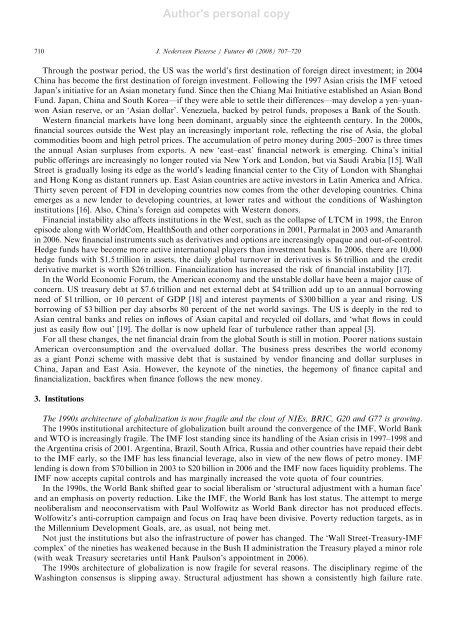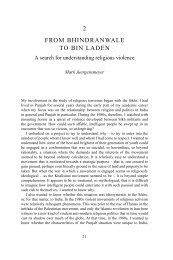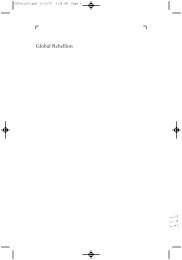New Glob Fu JFTR1275.pdf - Jan Nederveen Pieterse
New Glob Fu JFTR1275.pdf - Jan Nederveen Pieterse
New Glob Fu JFTR1275.pdf - Jan Nederveen Pieterse
You also want an ePaper? Increase the reach of your titles
YUMPU automatically turns print PDFs into web optimized ePapers that Google loves.
Author's personal copy<br />
710<br />
ARTICLE IN PRESS<br />
J. <strong>Nederveen</strong> <strong>Pieterse</strong> / <strong>Fu</strong>tures 40 (2008) 707–720<br />
Through the postwar period, the US was the world’s first destination of foreign direct investment; in 2004<br />
China has become the first destination of foreign investment. Following the 1997 Asian crisis the IMF vetoed<br />
Japan’s initiative for an Asian monetary fund. Since then the Chiang Mai Initiative established an Asian Bond<br />
<strong>Fu</strong>nd. Japan, China and South Korea—if they were able to settle their differences—may develop a yen–yuanwon<br />
Asian reserve, or an ‘Asian dollar’. Venezuela, backed by petrol funds, proposes a Bank of the South.<br />
Western financial markets have long been dominant, arguably since the eighteenth century. In the 2000s,<br />
financial sources outside the West play an increasingly important role, reflecting the rise of Asia, the global<br />
commodities boom and high petrol prices. The accumulation of petro money during 2005–2007 is three times<br />
the annual Asian surpluses from exports. A new ‘east–east’ financial network is emerging. China’s initial<br />
public offerings are increasingly no longer routed via <strong>New</strong> York and London, but via Saudi Arabia [15]. Wall<br />
Street is gradually losing its edge as the world’s leading financial center to the City of London with Shanghai<br />
and Hong Kong as distant runners up. East Asian countries are active investors in Latin America and Africa.<br />
Thirty seven percent of FDI in developing countries now comes from the other developing countries. China<br />
emerges as a new lender to developing countries, at lower rates and without the conditions of Washington<br />
institutions [16]. Also, China’s foreign aid competes with Western donors.<br />
Financial instability also affects institutions in the West, such as the collapse of LTCM in 1998, the Enron<br />
episode along with WorldCom, HealthSouth and other corporations in 2001, Parmalat in 2003 and Amaranth<br />
in 2006. <strong>New</strong> financial instruments such as derivatives and options are increasingly opaque and out-of-control.<br />
Hedge funds have become more active international players than investment banks. In 2006, there are 10,000<br />
hedge funds with $1.5 trillion in assets, the daily global turnover in derivatives is $6 trillion and the credit<br />
derivative market is worth $26 trillion. Financialization has increased the risk of financial instability [17].<br />
In the World Economic Forum, the American economy and the unstable dollar have been a major cause of<br />
concern. US treasury debt at $7.6 trillion and net external debt at $4 trillion add up to an annual borrowing<br />
need of $1 trillion, or 10 percent of GDP [18] and interest payments of $300 billion a year and rising. US<br />
borrowing of $3 billion per day absorbs 80 percent of the net world savings. The US is deeply in the red to<br />
Asian central banks and relies on inflows of Asian capital and recycled oil dollars, and ‘what flows in could<br />
just as easily flow out’ [19]. The dollar is now upheld fear of turbulence rather than appeal [3].<br />
For all these changes, the net financial drain from the global South is still in motion. Poorer nations sustain<br />
American overconsumption and the overvalued dollar. The business press describes the world economy<br />
as a giant Ponzi scheme with massive debt that is sustained by vendor financing and dollar surpluses in<br />
China, Japan and East Asia. However, the keynote of the nineties, the hegemony of finance capital and<br />
financialization, backfires when finance follows the new money.<br />
3. Institutions<br />
The 1990s architecture of globalization is now fragile and the clout of NIEs, BRIC, G20 and G77 is growing.<br />
The 1990s institutional architecture of globalization built around the convergence of the IMF, World Bank<br />
and WTO is increasingly fragile. The IMF lost standing since its handling of the Asian crisis in 1997–1998 and<br />
the Argentina crisis of 2001. Argentina, Brazil, South Africa, Russia and other countries have repaid their debt<br />
to the IMF early, so the IMF has less financial leverage, also in view of the new flows of petro money. IMF<br />
lending is down from $70 billion in 2003 to $20 billion in 2006 and the IMF now faces liquidity problems. The<br />
IMF now accepts capital controls and has marginally increased the vote quota of four countries.<br />
In the 1990s, the World Bank shifted gear to social liberalism or ‘structural adjustment with a human face’<br />
and an emphasis on poverty reduction. Like the IMF, the World Bank has lost status. The attempt to merge<br />
neoliberalism and neoconservatism with Paul Wolfowitz as World Bank director has not produced effects.<br />
Wolfowitz’s anti-corruption campaign and focus on Iraq have been divisive. Poverty reduction targets, as in<br />
the Millennium Development Goals, are, as usual, not being met.<br />
Not just the institutions but also the infrastructure of power has changed. The ‘Wall Street-Treasury-IMF<br />
complex’ of the nineties has weakened because in the Bush II administration the Treasury played a minor role<br />
(with weak Treasury secretaries until Hank Paulson’s appointment in 2006).<br />
The 1990s architecture of globalization is now fragile for several reasons. The disciplinary regime of the<br />
Washington consensus is slipping away. Structural adjustment has shown a consistently high failure rate.





